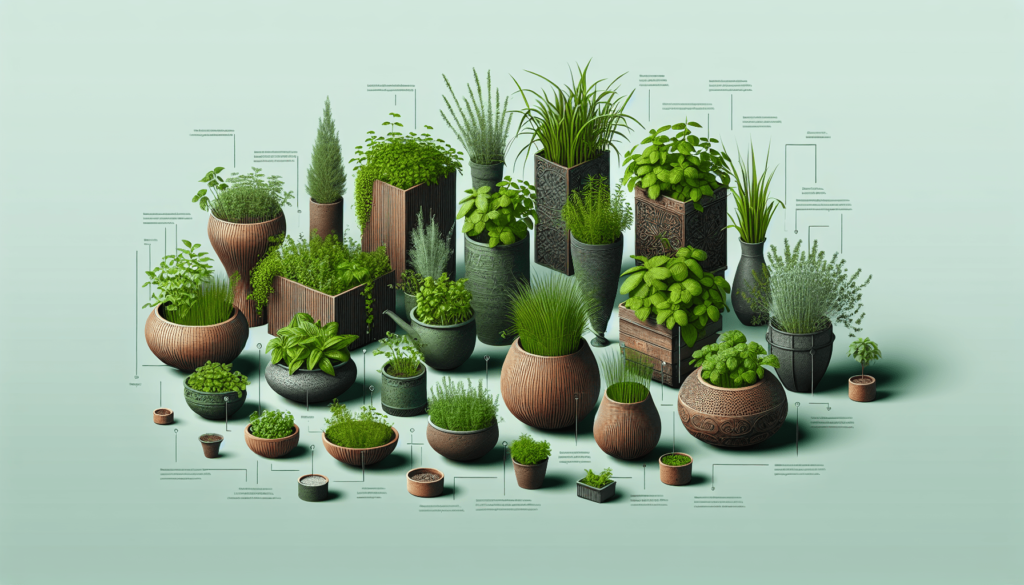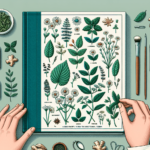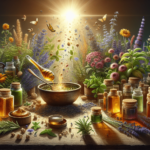So you’ve decided to start a herb garden, but you’re not quite sure where to begin. Look no further! This ultimate guide to garden planters for herbs has got you covered. Whether you have a spacious backyard or a tiny balcony, there are plenty of options to suit your needs. From traditional clay pots to modern hanging planters, we’ll explore the various types of planters and their benefits. We’ll also discuss important factors to consider, such as drainage, size, and material, to ensure your herbs thrive. With this comprehensive guide, you’ll be growing your very own fresh herbs in no time!
Choosing the Right Garden Planter
When it comes to growing herbs, choosing the right garden planter is essential for their health and success. The right planter will provide a suitable environment for your herbs to thrive, allowing you to enjoy a bountiful harvest all season long. In this comprehensive guide, we will explore the key factors to consider when selecting a garden planter for your herbs, the different types of planters available, design considerations, preparing the planter for planting, selecting suitable herb varieties, planting and caring for herbs in planters, managing planter location and sunlight, container gardening tips, and even how to decorate and personalize your garden planters. So let’s jump right in and get started on creating the perfect herb garden in your chosen planters!

Consider the Herb’s Growth Habit
The first important factor to consider when choosing a garden planter for your herbs is their growth habit. Herbs can have various growth habits, such as spreading, clumping, or trailing. It is important to choose a planter that provides enough space for the herb’s roots to spread and thrive. For herbs with spreading growth habits, a wider and shallower planter would be ideal, while herbs with clumping or trailing habits may benefit from deeper and narrower planters. Taking the growth habit of your herbs into account will help ensure they have enough room to grow and develop healthily.
Assess the Planter’s Drainage
Proper drainage is crucial for herb planters as excess moisture can lead to root rot and other fungal diseases. When selecting a garden planter, it is essential to assess its drainage capabilities. Look for planters that have drainage holes or the option to add them. Good drainage allows excess water to escape, preventing waterlogging and maintaining a well-aerated soil environment for your herbs. Plants grown in planters with poor drainage may suffer from water stress or even die. So, ensure that the planter you choose promotes adequate drainage for healthy herb growth.
Evaluate the Planter’s Material
Garden planters come in various materials, each offering its own advantages and disadvantages. Ceramic planters are popular for their aesthetic appeal and versatility. They can be glazed or unglazed, offering different moisture retention properties. Terracotta planters are known for their porous nature, allowing better airflow to the plant’s roots. Wooden planters are highly customizable and offer a natural and rustic look. Metal planters are durable and weather-resistant, but they can heat up quickly in direct sunlight. Plastic planters are lightweight, inexpensive, and offer good moisture retention. Each material has its own considerations regarding insulation, durability, and overall aesthetics. Consider the specific needs of your herbs and your own preferences when choosing the material for your garden planter.
Determine the Planter’s Size
The size of the planter is an important aspect to consider as it directly impacts the amount of soil and space available for your herbs to grow. Smaller planters may be suitable for growing a few herbs in a limited space, while larger planters can accommodate a greater variety and quantity of herbs. The size of the planter should also consider the mature size of the herbs you intend to grow. Some herbs, such as basil or mint, have expansive root systems and require larger planters to accommodate their growth. On the other hand, compact herbs like thyme or oregano may do well in smaller planters. Consider the size requirements of your herbs and the available space you have to determine the right size planter for your needs.
Types of Garden Planters
When it comes to garden planters for herbs, there is a wide variety of options available. Each type of planter has its own unique qualities and considerations. Let’s explore some of the most popular types of garden planters for herbs:
Ceramic Planters
Ceramic planters are a timeless choice for herb gardening. They come in various shapes, sizes, and colors, allowing you to find the perfect match for your garden aesthetics. Ceramic planters are known for their versatility and the ability to retain moisture, which can benefit herbs that prefer slightly moister soil. However, it is important to ensure that ceramic planters have proper drainage holes to prevent waterlogging and root rot. Additionally, ceramic planters can be heavy and require careful handling to avoid breakage. Consider the visual appeal and moisture needs of your herbs when choosing ceramic planters for your garden.
Terracotta Planters
Terracotta planters are classic options that offer a rustic and earthy look to your herb garden. These planters are made from clay and are known for their porous nature, which allows better airflow to the plant’s roots. The porosity also means that terracotta planters can dry out more quickly, requiring more frequent watering. A key consideration with terracotta planters is to ensure they have proper drainage holes, as excessive moisture retention can cause the planter to crack. Terracotta planters are an excellent choice for herbs that prefer well-draining soil and drought-tolerant varieties.
Wooden Planters
Wooden planters are popular for their natural and rustic aesthetic appeal. They can be crafted from various types of wood, such as cedar or redwood, which are naturally resistant to rot and decay. Wooden planters can be customized to fit your desired dimensions and can complement different garden styles. However, it is important to choose rot-resistant wood and line the planter with a protective barrier, such as plastic or landscape fabric, to prevent soil contact and prolong the planter’s lifespan. Wooden planters require regular maintenance, including staining or sealing, to protect them from the elements. Consider the overall look of your garden and the level of maintenance you are willing to undertake when choosing wooden planters for your herbs.
Metal Planters
Metal planters, such as those made from stainless steel or galvanized steel, offer durability and a sleek look to your herb garden. They are resistant to pests, rot, and decay, making them a low-maintenance option. However, metal planters can heat up quickly in direct sunlight, potentially causing soil temperature fluctuations that may affect herb growth. Insulating the inner walls of metal planters can help mitigate this issue. Additionally, metal planters can be heavier and more expensive than other options, so consider your budget and the visual appeal you are looking for when considering metal planters.
Plastic Planters
Plastic planters are lightweight, inexpensive, and readily available, making them a popular choice for herb gardening. They come in a wide range of sizes, shapes, and colors, allowing for easy customization. Plastic planters retain moisture well, which can be beneficial for herbs that prefer consistently moist soil. However, they may require additional monitoring and careful watering to avoid waterlogging. Plastic planters are also prone to fading or becoming brittle over time with exposure to sunlight. Consider the cost, longevity, and visual appeal when choosing plastic planters for your herb garden.
Vertical Planters
Vertical planters offer a unique and space-saving solution for herb gardening. These planters allow you to grow herbs vertically, utilizing unused wall space and maximizing your growing area. Vertical planters can be made from a variety of materials, such as fabric, plastic, or even repurposed pallets. They are suitable for a wide range of herbs and can create a stunning visual display. However, it is important to ensure proper irrigation and drainage in vertical planters to prevent uneven watering and potential water stress. Consider the available wall space and the aesthetics you want to achieve when considering vertical planters for your herb garden.
Design Considerations
Aside from the practical aspects of choosing a garden planter for your herbs, design considerations play an important role in creating an aesthetically pleasing and visually appealing herb garden. Here are some design considerations to keep in mind when selecting your garden planters:
Matching the Planter to Your Garden Style
Your herbs and the planter they are grown in should complement your overall garden style. If you have a traditional or cottage-style garden, ceramic or terracotta planters can add a charming and timeless touch. For a modern or contemporary garden, sleek metal or plastic planters may be a better fit. Wooden planters can suit a rustic or natural garden aesthetic. Consider the overall theme and style of your garden and choose planters that enhance the visual appeal.
Color and Texture Selection
In addition to the material and style of the planter, the color and texture can greatly impact the overall look of your herb garden. Vibrant-colored planters can add a pop of color and create a focal point in your garden. Neutral-colored planters can blend in seamlessly with the surrounding greenery. Textured planters, such as those with a rough or patterned surface, can add visual interest and dimension. Consider the color scheme of your garden and the visual impact you want to achieve when choosing the color and texture of your planters.
Playing with Shapes and Sizes
Experimenting with different shapes and sizes of planters can create visual interest and add depth to your herb garden. Mixing and matching planters of varying heights or placing planters in clusters can create a dynamic and eye-catching display. Consider the space you have available and the visual impact you want to achieve when selecting planters of different shapes and sizes.
Consider Planting Combinations
Planting combinations refers to the selection and arrangement of different herb varieties within your garden planters. Consider pairing herbs with complementary growth habits or contrasting leaf colors to create visually striking combinations. For example, pairing trailing herbs like thyme or creeping rosemary with upright herbs like basil or parsley can create a beautiful cascading effect. Experiment with different combinations and remember to consider the sunlight and water requirements of each herb to ensure successful growth.
Preparing the Planter
Once you have selected the perfect garden planter for your herbs, it is important to prepare it properly before planting. Follow these steps to ensure your planter is ready for the herbs to thrive:
Cleaning and Sterilizing the Planter
Before using a new planter or reusing a previously used one, it is crucial to clean and sterilize it. This helps remove any dirt, debris, or potential diseases that may be present. Wash the planter thoroughly with soap and water, and then disinfect it with a solution of one part bleach to nine parts water. Allow the planter to air dry completely before proceeding.
Adding Drainage Holes
If your chosen planter does not have drainage holes, you will need to add them. Good drainage is essential for healthy herb growth and preventing waterlogged soil. Use a drill with a suitable drill bit to create drainage holes in the bottom of the planter. The number and size of the holes may vary depending on the size of the planter and the specific herb’s drainage needs. Make sure the holes are evenly spaced and allow excess water to flow freely out of the planter.
Choosing Suitable Soil
Selecting the right soil is essential for the well-being of your herbs. Herbs generally prefer well-draining soil that is rich in organic matter. Choose a high-quality potting mix that is specifically formulated for container gardening. Avoid using garden soil or heavy soil mixes as they can become compacted and hinder root growth. Consider adding perlite or vermiculite to improve drainage and aeration. If you prefer a more customized soil mix, you can create your own by combining equal parts of compost, peat moss, and perlite or vermiculite.
Filling Planter with Soil
Once you have chosen the appropriate potting mix, fill the planter with soil, leaving enough space at the top for watering. Gently tamp down the soil to eliminate any air pockets but avoid compacting it too tightly. Fill the planter to a level that allows adequate space for the herb’s root system to establish and grow. Ensure that the soil is evenly distributed throughout the planter and level.
Selecting Herb Varieties for Planters
Now that you have prepared your garden planter, it’s time to choose the herb varieties that are best suited for container gardening. Herbs can be categorized into culinary herbs, medicinal herbs, and aesthetic herbs, each with its own unique attributes and uses. Consider the different options and select the herb varieties that align with your preferences and needs:
Choosing Culinary Herbs
Culinary herbs are the most commonly grown herbs and are used to enhance the flavor of various dishes. Popular culinary herbs include basil, thyme, oregano, rosemary, sage, and parsley. These herbs are easy to grow and thrive in containers, making them great choices for planters. Consider the herbs that you frequently use in your cooking and select varieties that suit the growing conditions of your chosen planters.
Considering Medicinal Herbs
Medicinal herbs have been used for centuries for their healing properties and health benefits. They can be grown in planters to provide a readily available source of herbal remedies. Examples of medicinal herbs include chamomile, lavender, echinacea, and lemon balm. Research the specific medicinal properties and growing requirements of different herbs before making your selection. Some medicinal herbs may have specific soil or lighting preferences, so be sure to consider these factors when choosing your planter.
Selecting Aesthetic Herbs
Aesthetic herbs are chosen for their visual appeal and the fragrance they add to the garden. These herbs can be used to create a sensory experience and enhance the overall ambiance of your outdoor space. Lavender, lemon verbena, mint, and scented geraniums are popular aesthetic herbs. Consider the colors, shapes, and scents you want to incorporate into your herb garden when selecting aesthetic herbs for your planters.
Choosing Compatible Herb Combinations
When planting herbs in a single planter or grouping multiple planters together, it is important to consider the compatibility of the herb combinations. Some herbs have different sunlight, watering, or soil requirements that may not be compatible with others. For example, herbs like lavender and rosemary prefer drier soil and full sunlight, while basil and parsley prefer consistently moist soil and partial shade. Research each herb’s specific needs and compatibility with other herbs to create harmonious herb combinations in your garden planters.
Planting and Caring for Herbs in Planters
Now that you have selected the herb varieties and prepared your garden planter, it’s time to plant and care for your herbs. Follow these guidelines to ensure your herbs thrive in their planters:
Sowing Seeds vs. Transplanting
Herbs can be grown from seeds or transplanted from established plants. Sowing seeds directly in the planter allows you to witness the entire growth process, from germination to harvest. Transplanting young herb plants, either purchased or grown from seeds, can help jumpstart their growth and speed up the time to harvest. Consider the time and effort you are willing to invest and the space available when deciding whether to sow seeds or transplant herbs in your planters.
Proper Planting Depth and Spacing
When planting herbs in your garden planter, it is important to follow the specific planting depth and spacing guidelines for each herb variety. Generally, herbs are planted at a depth of approximately twice the size of their seeds. Proper spacing ensures that each herb has adequate room to grow and access to nutrients and sunlight. Be sure to read the seed packet or plant tag for the recommended planting depth and spacing for the specific herbs you are growing.
Watering Needs
Proper watering is crucial for the health and growth of your herbs. Most herbs prefer consistent moisture but are susceptible to root rot if overwatered. Moisture requirements may vary depending on the specific herb variety and the size of the planter. As a general guideline, water the herbs when the top inch of soil feels dry to the touch. However, it is important to regularly monitor the moisture level and adjust your watering schedule as needed. Avoid allowing the soil to completely dry out or become soggy.
Fertilizing Guidelines
Herbs grown in containers may require additional nutrients to support their growth and productivity. Choosing a slow-release or organic fertilizer specifically formulated for herbs is ideal. Follow the manufacturer’s instructions for application rates and timing. Over-fertilizing can lead to excessive leaf growth and reduced flavor in culinary herbs. It is important to strike a balance and provide the necessary nutrients without overfeeding.
Pruning and Harvesting Techniques
Pruning and harvesting herbs regularly is essential for maintaining their health and encouraging continuous growth. Regularly trimming the tips of your herbs can promote branching and bushier growth. Harvesting the leaves, stems, or flowers when they are at their peak can ensure the best flavor and fragrance. Use sharp pruning shears or scissors to make clean cuts and avoid damaging the plant. Leave a portion of each herb plant intact to allow it to continue growing and replenish itself.
Addressing Pests and Diseases
Unfortunately, herbs are not immune to pests and diseases. Common pests that may affect herbs include aphids, spider mites, and whiteflies. Regularly inspect your plants for signs of pests and take appropriate measures to control or mitigate the infestation. Organic pest control methods, such as insecticidal soaps or neem oil, can be effective and safe for use on edible herbs. Be vigilant and address pest issues promptly to prevent extensive damage to your herbs. If your herbs develop signs of diseases, such as fungal infections or wilting, it is important to identify the specific disease and take appropriate action. Removing affected plant parts and using fungicides or other disease control methods may be necessary to prevent the spread of disease.
Managing Planter Location and Sunlight
The location of your garden planters and the amount of sunlight they receive are critical factors that directly affect the growth and development of your herbs. Here are some considerations to keep in mind when managing planter location and sunlight:
Choosing the Right Spot for Planters
When selecting a location for your garden planters, consider the sunlight requirements of your herbs. Most herbs prefer full sun, which generally means at least six hours of direct sunlight per day. Some herbs, such as mint or parsley, can tolerate partial shade. Choose a location that offers the appropriate amount of sunlight for your herbs to thrive. Additionally, consider other factors like wind exposure, access to water, and proximity to your kitchen or outdoor living space.
Understanding Herb Sunlight Requirements
Different herbs have varying sunlight requirements. Some herbs, like basil and rosemary, love full sun and require six to eight hours of direct sunlight per day. Others, like cilantro or chives, can tolerate partial shade and require only three to six hours of direct sunlight per day. Understanding the specific sunlight requirements of your herbs is crucial for proper placement and ensuring their optimal growth.
Considerations for Indoor vs. Outdoor Planters
Whether you choose to grow your herbs indoors or outdoors, there are specific considerations for each setting. Indoor planters may require supplemental lighting, such as grow lights, to provide sufficient sunlight for proper herb growth. Outdoor planters may need protection from harsh weather conditions, such as excessive heat or frost. Consider the advantages and limitations of each setting and choose the one that suits your herb varieties and the space available.
Protecting Planters in Extreme Weather
Extreme weather conditions, such as heatwaves or frost, can pose challenges for your herb planters. In hot climates, it is important to monitor the soil moisture levels more frequently and provide adequate shade or protection from excessive heat. In colder climates, protecting your planters from frost or freezing temperatures is crucial. Move the planters indoors or to a sheltered location to avoid damage caused by freezing temperatures. Insulating the planters or covering them with frost cloth can also provide protection during colder months.
Container Gardening Tips
Container gardening offers a flexible and versatile approach to growing herbs. Here are some additional tips to make the most of your garden planters:
Rotating Planters for Balanced Growth
To ensure balanced growth and prevent one side of the herb planter from receiving more sunlight than the other, rotate the planters periodically. This allows all sides of the plant to receive equal sunlight exposure and promotes even growth. Aim to rotate the planters every two weeks or as needed to ensure optimal sunlight accessibility.
Considerations for Multi-Tiered Planters
Multi-tiered planters, also known as vertical gardens or tiered plant stands, offer a space-saving solution for growing herbs in small spaces. When using multi-tiered planters, consider the sunlight requirements of each herb and place them accordingly. Herbs that prefer full sun should be placed on the top tiers, while those that tolerate partial shade can be placed on lower tiers. Remember to provide adequate spacing between tiers to prevent overcrowding and ensure each herb has sufficient room to grow.
Maximizing Small Spaces with Hanging Planters
If you have limited ground space, hanging planters can be a great way to maximize vertical space and grow herbs in unconventional areas. Hang planters from overhead structures, such as pergolas or wall-mounted brackets, or use railing hooks to attach them to balconies or fences. Hanging planters require careful watering and monitoring, as they may dry out more quickly than ground-level planters. Consider using self-watering systems or installing drip irrigation to ensure consistent moisture for your hanging herb planters.
Accessibility and Maintenance Considerations
When planning your container garden, consider the accessibility and maintenance requirements of the planters. Ensure there is enough space between planters to allow for easy watering, pruning, and harvesting. If you have physical limitations or prefer low-maintenance gardening, consider using raised planters or incorporating self-watering systems to reduce the frequency of watering. Accessibility and maintenance considerations can make your herb gardening experience more enjoyable and sustainable.
Decorating and Personalizing Garden Planters
Garden planters can be much more than simple vessels for growing herbs. They offer an opportunity to express your creativity and personalize your outdoor space. Here are some ideas for decorating and personalizing your garden planters:
Adding Personal Touches with Paint or Decals
Transform plain garden planters into works of art by adding a personal touch with paint or decals. Choose colors and patterns that complement your garden style and add visual interest. Hand-painted designs, stencils, or decals can enhance the overall aesthetics of your herb garden and create a unique display. Consider using weather-resistant paint or applying a clear sealant to protect the designs from fading or peeling over time.
Using Planters as Decorative Objects
Garden planters themselves can serve as decorative objects, adding visual appeal to your outdoor space. Explore different shapes, sizes, and textures of planters to create interesting focal points or groupings. Consider mixing planters of different materials or colors to create a visually dynamic display. Repurposing vintage or antique containers as planters can add a touch of nostalgia and character to your garden.
Creating a Theme or Color Scheme
Unify your herb garden with a specific theme or color scheme to create a cohesive and aesthetically pleasing display. Select planters, herbs, and accessories that align with your chosen theme or color palette. For example, create a Mediterranean theme with terracotta planters and herbs like rosemary, thyme, and lavender. Alternatively, create a vibrant herb garden with planters and herbs in various shades of green and purple. Let your creativity guide you in crafting a unique and visually appealing herb garden.
Popular Brands and Where to Buy
When it comes to purchasing garden planters, there are numerous brands and retailers to choose from. Here are some popular brands and places where you can buy quality garden planters for your herb gardening needs:
Brand 1
Brand 1 offers a wide range of garden planters in various materials, sizes, and styles. Their planters are known for their durability and design aesthetics. You can find Brand 1 planters at select garden centers and online retailers.
Brand 2
Brand 2 specializes in eco-friendly and sustainable garden planters. Their planters are made from recycled materials and promote environmentally conscious gardening. Brand 2 planters are available at local garden centers and through their online store.
Brand 3
Brand 3 offers innovative and space-saving planters for urban gardening. Their vertical and hanging planters are designed to maximize small spaces and allow for easy herb cultivation. Brand 3 planters can be found at specialty garden stores and online retailers.
Online Retailers
Online retailers such as Amazon, Wayfair, and Etsy offer a wide selection of garden planters in various styles and price ranges. These platforms allow you to browse through numerous options, read customer reviews, and compare prices, making it convenient to find the perfect garden planter for your herb garden.
Local Garden Centers
Local garden centers are excellent sources for quality garden planters. They often carry a variety of planters in different materials and sizes, allowing you to see and feel the planters in person before making a purchase. Visiting a local garden center also provides an opportunity to seek expert advice and guidance from knowledgeable staff members.
By considering the herb’s growth habit, assessing the planter’s drainage, evaluating the planter’s material, and determining the planter’s size, you can select the right garden planter for your herbs. Whether you choose ceramic, terracotta, wooden, metal, plastic, or vertical planters, each offers unique advantages and considerations. Design considerations, such as matching the planter to your garden style, color and texture selection, playing with shapes and sizes, and considering planting combinations, allow you to create a visually appealing herb garden. Preparing the planter by cleaning and sterilizing, adding drainage holes, choosing suitable soil, and filling it with soil sets a strong foundation for successful herb growth. Selecting appropriate herb varieties, planting and caring for them in planters, addressing pests and diseases, and managing planter location and sunlight ensure healthy and productive plants. Implementing container gardening tips, such as rotating planters, utilizing multi-tiered and hanging planters, and considering accessibility and maintenance, maximize the potential of your herb garden. Lastly, decorating and personalizing your garden planters with paint or decals, using planters as decorative objects, and creating a theme or color scheme infuse your own style into your herb garden.
With this comprehensive guide, you are now equipped with the knowledge and insights to choose, plant, care for, and personalize your garden planters for a flourishing and visually stunning herb garden. Happy planting and may you enjoy a plentiful harvest of delicious and aromatic herbs!





